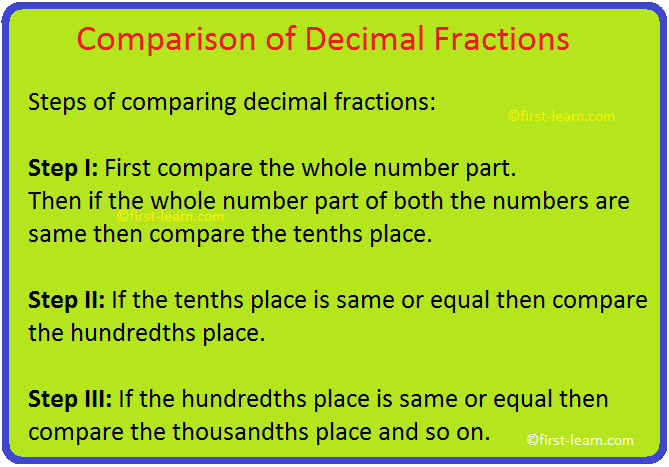Comparison of Decimal Fractions
This topic would deal with comparing decimal fractions. For comparing decimal fractions we first compare the whole number part then compare the fractional part. For comparing the fractional part we first compare the tenths place, then hundredths place, then thousandths place and so on.
For example:
Compare 0.55 and 0.58
We cannot compare the whole number part as both are same
We are comparing the fractional decimal part
0.55 = 5 tenths + 5 hundredths
0.58 = 5 tenths + 8 hundredths
Now 5 tenths = 5 tenths
We will now compare next place
5 hundredths < 8 hundredths
Steps of comparing decimal fractions:
Step I: First compare the whole number part.
Then if the whole number part of both the numbers are same then compare the tenths place.
Step II: If the tenths place is same or equal then compare the hundredths place.
Step III: If the hundredths place is same or equal then compare the thousandths place and so on.
Here are few examples of comparing decimal fractions:
1. Compare 45.63 and 45. 976
45.63 = 4 tens + 5 ones + 6 tenths + 3 hundredths
45.976 = 4 tens + 5 ones + 9 tenths + 7 hundredths + 6 thousandths
4 tens = 4 tens
5 ones = 5 ones
6 tenths < 9 tenths
Therefore, 45.63 < 45.976
2. Which is greater 90.678 or 65.321?
90.678 = 9 tens + 0 ones + 6 tenths + 7 hundredths + 8 thousandths
65.321 = 6 tens + 5 ones + 3 tenths + 2 hundredths + 1 thousandths
Now we see,
9 tens > 6 tens
Hence 90.678 >65.321
3. Compare 45.213 and 785. 563
45.213 = 4 tens + 5 ones + 2 tenths + 1 hundredths + 3 thousandths
785.563 = 7 hundreds + 8 tens + 5 ones + 5 tenths + 6 hundredths + 3 thousandths
Now we will first compare the integral part
4 tens < 7 hundreds
Therefore, 45.213 < 785.563
4. Which is greater 32.124 or 32.128
32.124 = 3 tens + 2 ones + 1 tenths + 2 hundredths + 4 thousandths
32.128 = 3 tens + 2 ones + 1 tenths + 2 hundredths + 8 thousandths
Now we will first compare the integral part
3 tens = 3 tens
2 ones = 2 ones
Now we will compare the decimal fraction part
1 tenths = 1 tenths
2 hundredths = 2 hundredths
4 thousandths < 8 thousandths
Therefore, 32.124 < 32.128
From Comparison of Decimal Fractions to HOME PAGE
Recent Articles
-
What Is Plasma? | Blood Plasma | Proteins | Nutrients | Cholesterol
Nov 07, 25 10:29 AM
Blood is a mobile fluid which is a connective tissue and is derived from the mesoderm like cell any other connective tissue. Colour of blood is reddish and that flows inside the blood vessels by means… -
Disorders of Respiratory System | Tuberculosis | Pleurisy | Emphysema
Oct 28, 25 11:39 PM
Tuberculosis is very common disease and is caused by a type of bacteria called Mycobacterium tuberculosis. This disease causes different trouble in the respiration and infection of several parts of th… -
Regulation of Respiration | Respiratory Centres | Inspiratory Area |
Oct 14, 25 12:13 AM
Respiratory Centre is the area that controls the rate of respiration and it is observed to be located in medulla oblongata and pons. Respiratory Centre has the following will dispersed components like… -
Explain Transport of Gases | External Respiration | Tissue Respiration
Oct 09, 25 11:35 PM
In humans gaseous exchange is completed in the following ways the steps are - External Respiration or Breathing - Breathing in false taking in of Oxygen and giving out of carbon dioxide in the body. M… -
Kind and Number of Teeth | Location of Teeth in Mouth | Care of Teeth
Sep 11, 25 12:52 AM
Kind and Number of Teeth







New! Comments
Have your say about what you just read! Leave me a comment in the box below.